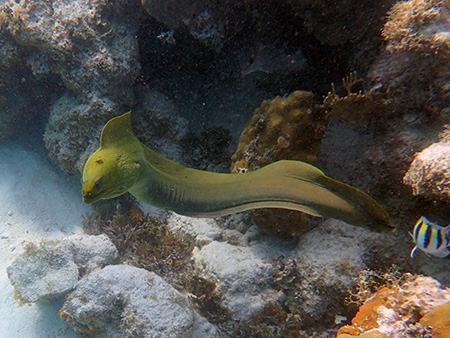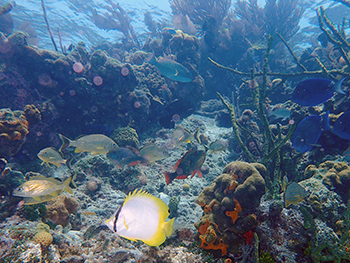La Poza
Geologists are uncertain about the development of this geographic formation that runs parallel to shore for about a half mile. The trench begins shallow then becomes wider and deeper. On one side is a coral wall, on the other is a sloping, sandy hill.

Because there are strong currents and nutrient-rich water, this is the favorite spot for large fish and rays.
Immediately after the swim-through, you will see schools of large tarpon congregating along the coral wall as well as schools of jacks and snapper.
This dive ends at a large rock formation called, the “Copa del Mundo” or the world cup, that rises from the bottom to approximately 15 feet below the surface of the water, which is where we enjoy great coral and a variety of fish while performing our safety stops.
La Chimenea
“The Chimney” is a coral wall that drops down from 40 to 110 feet surround by sand flats that extend into deeper water. A common entry will be to drop down 50-60 feet and swim along until you reach “La Catedral,” which is a large cavern. Often you will see tarpon and barracuda here, with the light entering through a large hole in the ceiling providing a beautiful backdrop for your photos and videos. There are also swim throughs and an ascent through the chimney for more advanced dives.
Alejandro’s Reef
The unique horseshoe-shaped wall with large coral heads in the center make this a very unique dive. Here you may see moray eels and will enjoy black wire coral cascading from many of the overhangs.
There are large coral heads in the center, swim throughs where moray eels like to hide, and lots of black wire coral on the overhangs.
 Doña Nica
Doña Nica
Two coral formations are the centerpiece of this dive that spans from 30-50 feet, making it a great site for divers of all levels and it is full of marine life. Alongside these two formations, in slightly deeper water are additional formations that have overhangs and provide the opportunity to see turtles, grouper and more.
Hob Na
About 30 minutes north, there are tall, narrow canyon formations, making it possible to dive both along the top of the reef and along the sides. We frequently see grouper here, some of whom appear to nest in this beautiful location.
In addition to scuba diving, we offer bird watching trips, snorkeling and boat tours to see and experience the diverse biosphere surrounding Xcalak.
